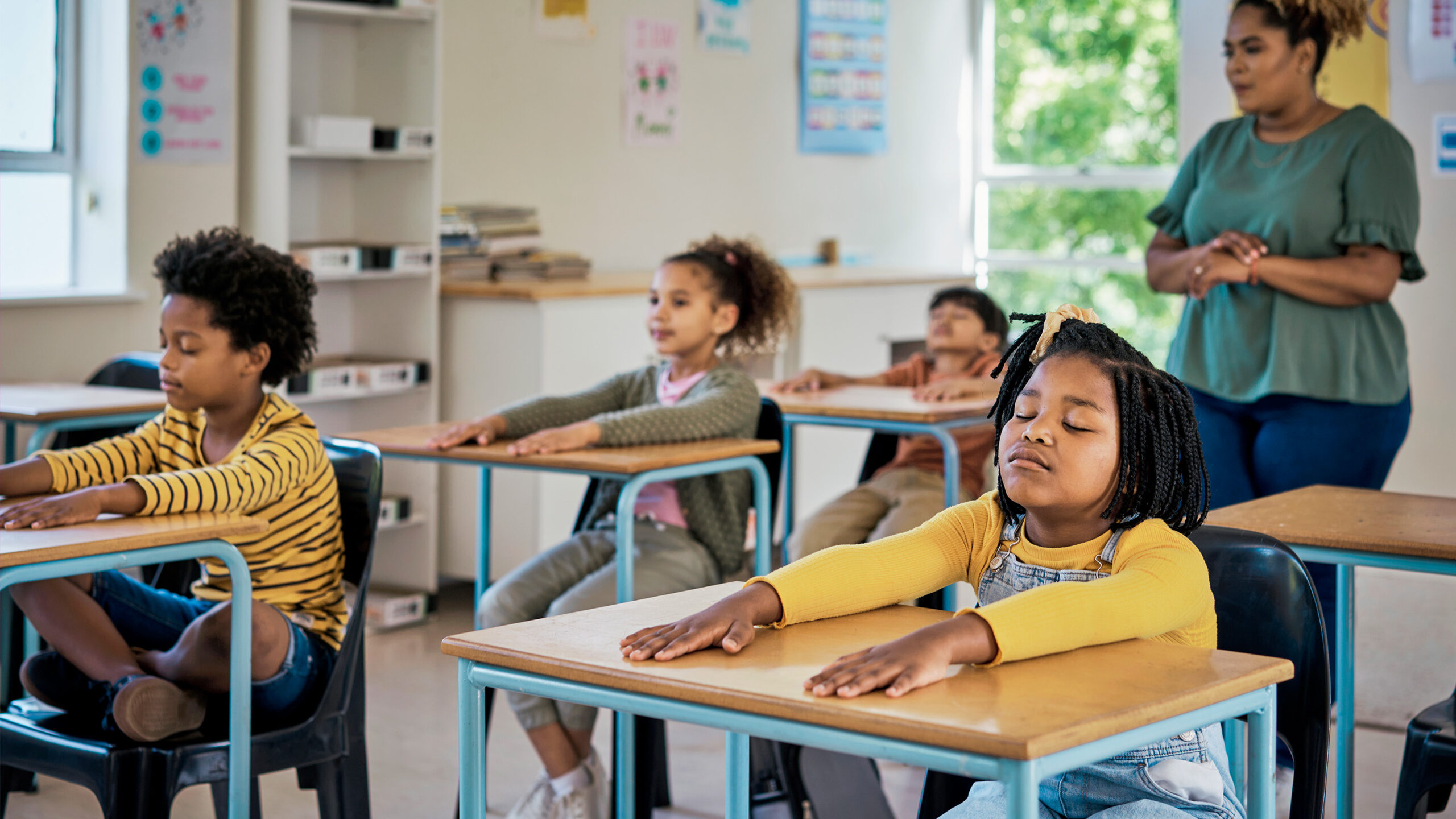[ad_1]
College is all about giving faculty college students the skills they need to succeed. That truly applies to finding out, writing, and math, nonetheless there’s a rising understanding amongst elementary teachers that colleges should even be instructing a further primary means: self-regulation.
“I found that fascinated by habits objectively—as a means to be taught fairly than merely just about nearly as good or unhealthy—was immensely helpful in my functionality to data kids in finding out to control their habits,” writes specific coaching coach Nina Parrish.
There are a choice of proactive steps which will help protect faculty college students composed. Repeatedly checking in with kids—and establishing relationships with them—can improve their sense of safety throughout the classroom and supplies them an opportunity to share how they’re feeling, writes educator and principal Jasmine Brann. Plus, sticking to routines and simplifying your classroom expectations can decrease the hazard of outbursts born from frustration or confusion, write coaching researchers Donna Wilson and Marcus Conyers.
Nevertheless even with these proactive practices in place, youthful faculty college students with still-developing brains can wrestle to control their very personal reactions. Listed under are some teacher-tested strategies which will help endow elementary faculty college students with the essential, lifelong means of self-regulation.
Prepare kids about their brains: To raised regulate themselves, kids wish to know what’s occurring inside their heads. Educator Kathryn Fishman-Weaver recommends instructing the important building and efficiency of the limbic system—the thoughts’s emotional administration center. She makes use of a mnemonic gadget she developed to help kids distinguish utterly totally different parts of the system: Hippos’ tooth have horrible odor (hippocampus, thalamus, hypothalamus, amygdala, and olfactory bulb). Fishman-Weaver says this crash course helps kids discover not that emotions and contemplating are separate processes, nonetheless fairly that “feelings, concepts, and behaviors end in coordinated responses all through the thoughts” which will affect faculty college students’ consideration span, memory, and authorities functioning.
Develop emotional vocabulary: To know and concentrate on their emotions, kids desire a wider emotional vocabulary, too. Fishman-Weaver challenges faculty college students to hold out “feeling brainstorms,” whereby they’re tasked to “contemplate 20 sorts of utterly happy or sad.” As they generate further phrases and share them amongst each other, it’s further seemingly that they’ll begin to make use of additional precise phrases to elucidate their very personal emotions ultimately—like “anxious,” “excited,” or “completely happy.” As quickly as faculty college students have a healthful emotional vocabulary, devices like mood meters, emotion wheels, and mood scales might assist them monitor how their emotions change day-to-day.
Chat it out with a stuffed animal—or a plant: If faculty college students are feeling careworn, they might wish to converse by means of their feelings—nonetheless it’s not on a regular basis important {{that a}} human be the one listening. When educator and assistant professor of coaching Lori Desautels’ elementary faculty gave faculty college students stuffed animals to handle and chat with, “we seen a peaceable in numerous faculty college students that we had not seen sooner than.” Equally, a pineapple plant (nicknamed Patricia) in Lisa Tiemersma’s fourth-grade class helped calm kids down who had been upset and cheer up kids who had been sad.
Create a peace nook: At Fall-Hamilton Elementary in Nashville, every classroom has a delegated “peace nook”—an space for teenagers who should self-regulate, full of a bean bag chair, sensory toys, stuffed animals, and charts describing calming respiration and counting exercises. Faculty college students choose when to go to the nook, and their coach items a five-minute timer, nonetheless the pupil can request further time if wished. “I’ve seen a great deal of my kids this yr—in its place of merely exploding or getting really upset—say ‘OK, I have to go to the peace nook,’” says fourth-grade coach Whitney Holland.
Use choice time: Free choice time, when structured correctly, might assist faculty college students examine self-regulatory talents. For example, at Structure Oak Worldwide Academy in West Hartford, Connecticut, kids can go to various areas of the classroom all through free time (like “blocks” or “dramatic play”)—however when that house is at functionality, they may put their establish on a prepared document. Faculty college students can ask their coach to set a timer for after they’ll be allowed to alter into the world— “and having that seen of the time getting a lot much less and fewer” lets them develop their endurance, says pre-Okay coach Cindy Barron.
Measure the dimensions of a problem: To many youthful kids, every draw back can actually really feel monumental, and subsequently deserving of an infinite response. Teachers might assist faculty college students put points into perspective. For example, Washington elementary coach Anna Parker has faculty college students cost points—like “Anyone took your pencil” and “A member of the household is throughout the hospital”—on a scale from 1 to 5 and mirror on what the appropriate response to each is probably. Parker discusses calibrating responses all yr lengthy “so that faculty college students throughout the second will suppose, ‘I can take a second, then I can react appropriately.’”
Use picture books: Picture books might assist kids examine emotions and the proper approach to handle them. Educator Kristin Rydholm recommends books like Large Feelings, which “identifies and addresses the intense emotions that kids usually experience when attempting to work collaboratively.”
Morning check-ins: Quick check-ins initially of the day might assist faculty college students mirror on what they’re feeling. Ask faculty college students to share one “rose” (one factor they’re passionate about) and one “thorn” (one factor they’re nervous or upset about), says educator Alex Venet. UCLA Graduate College of Education instructor Rebecca Alber suggests asking faculty college students to elucidate how they’re feeling in a single phrase. They may start with phrases like “good” or “unhealthy,” nonetheless with further progress of their emotional vocabulary, they might progress to “anxious” or “serene.”
Picture your peaceful place: A second of conscious meditation might assist kids regulate themselves. When kids are overcome by their feelings, occupational therapist Lauren Brukner recommends asking them to close their eyes and “visualize a second or place that makes them actually really feel most likely probably the most peaceful,” like a selected room of their residence or collaborating in with a particular toy. Picturing every aspect—every sound, every scent—might assist calm faculty college students who’re “feeling extreme ranges of emotionality.”
Pleasurable physique actions: Stretching, bending, and balancing exercises current sensory enter which will help regulate sturdy emotions, Brukner says. All through a transition interval at school, as an example, ask faculty college students to face straight, then “use your correct arm that may help you bend your left knee in the direction of your shoulder, and keep this place for five seconds,” sooner than repeating it with the left arm and correct knee. Desautels writes that telling faculty college students to clench and launch the muscle tissue of their palms and faces can have a similar impression.
Write down your values: When a person takes some time to reflect on and write down their core values, evaluation reveals this “improves self-importance, authorities carry out, and inhibitory administration,” Brukner writes. She asks faculty college students to jot down down “10 points that define who you are and make you specific.” Penning this document helps kids self-regulate throughout the second, nonetheless Brukner moreover recommends that faculty college students protect it someplace shut to permit them to seek the advice of with all of it yr lengthy, “comparable to subsequent to your mattress or pinned up in your workspace.” Equally, Desautels asks faculty college students to reflect on the “anchors” of their life that stabilize them—people they care about and perception, calming places, or pets. Faculty college students can return to this document of anchors—in order so as to add to it, or just study over it—at any time once they’re feeling overwhelmed.
Leverage the power of nature: Connecting kids with the pure world has wide-ranging psychological benefits, evaluation reveals—along with a lot much less whole stress. “In case your faculty doesn’t have simple accessibility to nature, you probably can nonetheless help faculty college students experience the magic of nature in some methods,” write Tiemersma and Brown—like rising an avocado plant from its pit, starting a college yard with calming aromatic herbs, or hanging a hen feeder near your window and monitoring what utterly totally different species go to it.
Optimistic self-talk: Faculty college students’ stress usually derives from feeling like they’re not okay—or simply unable to carry out a given job. Instructing them to develop the conduct of optimistic self-talk throughout the face of challenges might assist. “Inform your faculty college students that after they’ve a unfavorable thought of themselves, they may change it with an affirmation,” suggests Brukner—like “I can utterly do this!” or “I can actually really feel proud that I’m attempting my best!”
Simple respiration exercises: Respiration exercises have a calming impression, making them an essential machine for self-regulation. Brukner recommends telling faculty college students, “Breathe in by means of your nostril slowly for 4 seconds, keep, then breathe out by means of your mouth slowly for six seconds.” As an add-on, Desautels asks faculty college students to put one hand on their stomach and one hand in entrance of their nostril: As they breathe in; they actually really feel their stomach enhance, and as they breathe out, they actually really feel warmth air hit their hand. Instant faculty college students to “exhale away” any unfavorable concepts they is probably feeling, Desautels says.
- Determine Scribbles: Have faculty college students write their establish 4 events with their dominant hand and 4 events with the alternative hand. Afterward, concentrate on the way in which it felt; which was harder? Why?
- The Junk Bag: Desautels has a bag filled with junk drawer objects—shoelaces, markers, a can opener, and lots of others. She picks an merchandise from the bag and asks faculty college students to provide you two strategies the factor is perhaps used exterior of its meant operate. They will write or draw their options.
- Invisible Footage: Pair off faculty college students, and have one draw a picture throughout the air whereas the alternative guesses what it is. To slim the guessing, you possibly can present a category like “meals” or “places.”
Calming sounds: Desautels makes use of a variety of environment friendly sounds in her classroom—rain sticks, bells, chimes, peaceful music—nonetheless her go-to is the Tibetan singing bowl. Sitting in a circle and respiration deeply, “faculty college students shut their eyes and be all ears to the tone until they may’t hear it any longer,” she writes. “When this happens, they elevate their palms throughout the air.”
Categorical emotions with paintings: Inventive actions might assist kids course of and categorical emotions, along with “create a manner of safety and luxurious, reducing stress,” writes Desautels. In a single train, she provides faculty college students a little bit of paper and prompts them to fill it with various colors, traces, and shapes. She then asks faculty college students: Which coloration is indignant? Which type feels uncared for? Which traces are nervous? And why? “You probably can ask faculty college students how their footage are like them and the way in which they’re utterly totally different.”
Self-regulating video video games: Many video video games require players to exhibit restraint, which can assist kids develop self-discipline over their our our bodies and brains. For example, video video games like Purple Delicate, Inexperienced Delicate and Freeze “require members to exert self-control,” write Wilson and Conyers.
Create time to debate: Even if you happen to occur to actually really feel resembling you’ve given your faculty college students all the devices they need to self-regulate, some kids are sure to have difficulties. In these situations, it’s helpful to make time to speak with faculty college students one-on-one. “Youngsters need objective, nonjudgmental options in order to reinforce their habits,” says Parrish. “When a problem arises, uncover a peaceful time to debate what went mistaken, why, and the way in which it could be handled otherwise subsequent time.”
Ask Edutopia AIBETA
Responses are generated by artificial intelligence. AI may make errors.
[ad_2]
Provide hyperlink



